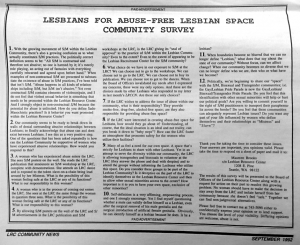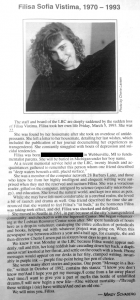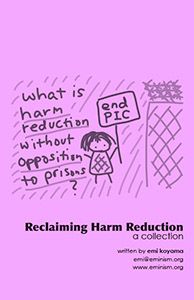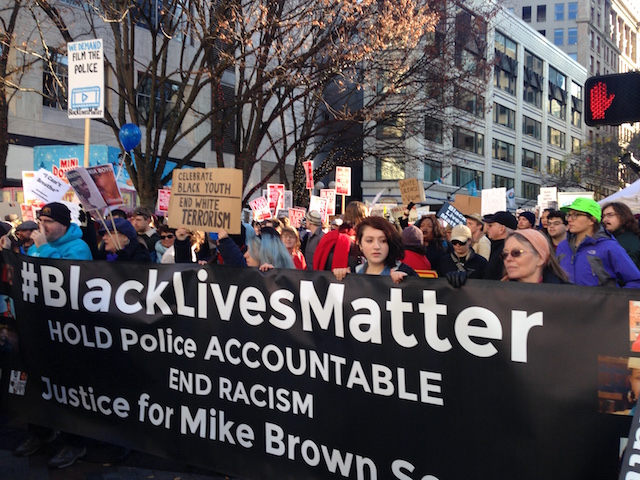On Monday, October 10th, Seattle Civil Rights and Labor History Project at the University of Washington, Department of History will celebrate the opening of the new LGBTQ Seattle Activism Project curated by doctoral student Kevin McKenna. The Seattle Civil Rights and Labor History Project already offers an amazing collection of historical materials and testimonies about civil and labor rights, so I was excited to hear about the launch of this new section.
The news of its opening also reminded me that I had done some research about an important part of Seattle’s lesbian and transgender history last year at the Seattle Public Library but procrastinated documenting what I found, and motivated me to finally do just that.
My research was about Filisa Vistima, a 22-year old trans woman living in Seattle who committed suicide on March 1993. In addition to being transgender, she was an active member of local lesbian community, volunteering her time at Seattle’s Lesbian Resource Center, which has since been closed. Last entries of her diary, archived by trans activist and writer Cristan Williams document her struggle with love, life, depression, and (often internalized) transphobia:
I am encountering many old desires of mine, e.g. swimming. By the comments [name withheld] has mentioned to me (“Your hands are large,” “You’re shaped like a boy” and so forth), I have been self-conscious of myself. I wish I was anatomically “normal” so I could go swimming.
If i was “normal” I would no longer have any reason to hide behind my clothes other than to hide my modesty. I could go swimming without clothes… I would love to do that so much!!
But no, I’m a mutant, Frankenstein’s monster.
Now I am feeling the same feeling I had some days ago but forgot about them, the feeling that I hate myself, the physical self. I remember having these feelings when I was a child, hitting thighs with my hands so I would cry. I’m, crying now…
[…] I feel inferior to “real women” and I may never be able to resolve the conflict.
(From Filisa Vistima’s Diary, January 5, 1993)
In The Transgender Studies Reader, trans historian Susan Stryker adds further context to Filisa’s suicide:
What drove her to such despair was the exclusion she experienced in Seattle’s queer community, some members of which opposed Filisa’s participation because of her transsexuality–even though she identified as and lived as a bisexual woman. The Lesbian Resource Center where she served as a volunteer conducted a survey of its constituency to determine whether it should stop ofering services to male-to-female transsexuals. Filisa did the data entry for tabulating the survey results; she didn’t have to imagine how people felt about her kind. […] Even in death she found no support from the community in which she claimed membership. “Why didn’t Filisa commit herself for psychiatric care?” asked a columnist in the Seattle Gay News. “Why didn’t Filisa demand her civil rights?” In this case, not only did the angry villagers hound their monster to the edge of town, they reproached her for being vulnerable to the torches. Did Filisa Vistima commit suicide, or did the queer community of Seattle kill her?
Cristan Williams also writes:
From what I can ascertain, prior to her Filisa’s death, she was made responsible for entering data from a Lesbian Resource Center (LRC) survey asking their service population if they felt that the LRC should continue to provide services to MTF transsexuals. RadFems had taken a hard line against providing services to transsexuals and Filisa was the one who had to record each venomous RadFem objection just prior to her death.
In the footnote, Stryker clarifies that her description “draws extensively on, and sometimes paraphrases” opinion pieces written by Margaret Deidre O’Hartigan and Frederic Kahler (separately) and published several months after Filisa’s death in Bay Times, a weekly LGBT community newspaper in the San Francisco Bay Area.
However, in my research I found out that some important details surrounding Filisa’s death were not entirely accurate.
There was a major controversy among members of Seattle’s lesbian community, but it mainly was over the acceptability of S/M in lesbian community, not transgender issues. The August 1992 issue of LRC Community News, the monthly publication of the Lesbian Resource Center, reported that “Seattle will play hostess to POWERSURGE, the first international Lesbian SM conference ever held.” “It is an event that heralds a new chapter in lesbian herstory,” proclaimed author Julia Kaplan.
The conference was being organized by Outer Limits, a local lesbian S/M group that held orientation meetings for new and prospective members at LRC, whose presence at the community center was heavily disputed by lesbians who believed that S/M glorified abuse and violence against women. Community member Maureen Brooks submitted a letter published in the same issue of LRC Community News arguing:
Once upon a time the Lesbian Resource Center was focused on creating a safe space for Lesbians to congreate. All Lesbians. It no longer serves that purpose.
[…] For example, the Lesbian Resource Center has become a staunch supporter of the S/M crowd. You can now attend workshops at the Lesbian Resource Center that offer actual demonstrations of Lesbian style sado-masochism. […]
What does S/M have to do with being a Lesbian? What does a trans-gender male or female have to do with being Lesbian? […] The Lesbian Resource Center is Lesbian space. […] My life has been dedicated to Honoring Women and the Female Energy. Obviously, the Lesbian Resource Center does not share in that commitment.
Brooks ends her letter by urging similarly minded lesbians to join her fight against the LRC leadership.
I don’t believe that I’m the only one who feels this way abut what’s happening in our space. […] Our concerns aren’t being represented at the Lesbian Resource enter. Our concerns are real and need to be heard before our Lesbian space is taken completely away from us. I can write letter after letter of protest, and the Board of Officers [of the LRC] will answer each letter praising the god of diversity. One person cannot accomplish change. But together we can reclaim our space and make it safe for Lesbians again. Talk to me. My telephone number is [redatcted].
Brooks does mention her opposition to transgender inclusion at the LRC in the passing, but the bulk of her arguments revolve around the acceptance of S/M at the LRC, as understood by other readers who sent in their criticisms of Brooks’ position in the September issue of the LRC Community News:
You talk about what you think the S/M women do in the LRC “space”. I know you haven’t encountered the shocking display of someone actually practicing S/M when you walk through the LRC door. That would be non-consensual, and that’s not what S/M is about. So it’s KNOWING that they were THERE at some point, and might be THERE again that bothers you. (name withheld)
[…] think about the fact that S/M or transgender women who love other women are also lesbians, and therefore have the same right to the LRC as you. […] I fail to see how an S/M workshop on, say, Tuesday makes the LRC “unsafe” for you on Wednesday (or Tuesday, for that matter). (Tonya Mikulas)
How does an event that happens when you are not in the LRC make it unsafe for you to be there at some other time? […] I understand that you may disapprove of me or the other Lesbians based on your own self-definition and “I honor that self-definition in all of us,” yet I realize that the LRC can be, and is, a safe place for both of us, for all Lesbians, for all women.” (Jane Seidman Vosk)
I am very involved in the lesbian S/M community and I do not know of anyone who either hangs out there [at the LRC] or wishes to “take it over.” I don’t understand her [Brooks’] paranoia just because diverse lesbians occasionally meet there and do not fit her lesbian standards. […] I believe that the LRC News handled itself in a fair and true journalistic manner by reflecting the very diversity of which she wrote, by including both her anti-S/M letter and, on the following page, a big story of POWERSURGE, the upcoming Seattle S/M lesbian conference.
All through her letter she referred to S/M dykes as not being lesbians. She wrote about female energy and then referred to the God, not Goddess, of diversity. I’d stake my Goddess-filled leather up against her bigoted cotton drawstrings any day and I’d still come up a dyke! (Julia Kaplan)
I wish to note the number of leather dykes who work in leadership positions in our local, national, and international community. To deny these women–these lesbians–full participation in the LRC is ludicrous! […] My experience with S/M dykes at [sic.] that of all sub-groups within the lesbian community, these are the women most ready to come out, step up, and volunteer their time to their sisters and brothers. […] To restrict the LRC to only a particular type of lesbian is to restrict the LRC’s purpose–and ultimately, the LRC’s funding and thus its ability to survive. I ask all of you to consider what could be accomplished if people like Ms. Brooks stopped spending their time and energy worrying about “how do I keep THEM out” and instead spent it on “how can I keep US strong.” (Karen T. Taylor)
There are many lesbians who share Brooks’ anti-S/M attitude. Many S/M dykes once felt this way too. I encourage those who feel this way to learn more of what S/M is about before passing judgment on the personal lifestyle choices of others. […] As lesbians we are a diverse group with diverse needs and thank Goddess for that! I wish us all support and resources on our paths toward empowerment. I am an S/M dyke and the LRC is as much for me as it is for Maureen Brooks. (Jennifer Greenstein)
The letters section also included a statement, signed by dozens of S/M lesbians, that simply noted “We, the undersigned, feel that S/M lesbians have as much right to use the LRC as any other lesbian.”

Letters published in this issue of the LRC Community News were all in support of S/M lesbians in the LRC and larger lesbian community, but Brooks published her own “community survey” as a paid advertisement on the same issue under the ad-hoc group “Lesbians for Abuse-Free Lesbian Space.”
The “community survey” contained twelve items that are leading questions designed to promote Brooks’ own opinions on issues at hand and seeking agreement. For example, the question number three reads:
A woman who has experienced abuse enters the LRC. She sees S/M posters on the wall. She reads the LRC publication that announces an S/M workshop at the LRC, complete with demonstrations. She attends an LRC dance and is exposed to the token slave-on-chain being led around by her Mistress. What is the possibility of this woman feeling safe at the LRC or any of its functions? What is our responsibility to this woman?
Brooks questions the inclusion of “bisexual and transgender community” in the LRC (questions nine, eleven and twelve) as well as “whether a male can validly define himself as a Lesbian, even after the surgical removal of his male genitalia and the surgical introduction of artificial female genitalia” (question ten) near the end of the survey, but the focus of the survey clearly is the issue of S/M (questions one through eight and twelve).

The survey concludes by asking readers to submit their responses to “Maureen Brooks c/o Lesbian Resource Center,” promising that “the results of this survey will be presented to the Board of Officers of the Lesbian Resource Center along with a request for action on their part to resolve this growing problem.”
The publication of the anti-S/M and anti-bi/trans survey as a “paid advertisement” in the LRC Community News resulted in a flood of criticisms against its editors, some of which were published in the next (October) issue.
As a dyke who has been involved with the LRC since 1976 (such as LMNDF, workshops, discussion groups, guest speakers, etc.), I clearly question the continual discussion and on-going attacks on s/m dykes and other groups. All dykes should have equal access to the LRC and its resources by virtue of simply being dykes. i am the s/m dyke recently referred to in your (newspaper), but not by name. If any womyn on the LRC board, staff, etc. have questions as to how i have run my workshops and/or what was said or done, ask me directly. Do not use covert references to third hand instances such as Maureen has done in her letter and her survey. (slave falcon, with full support of her Mistress Kate)
As a Queer woman and past contributor, volunteer and client of the LRC, I feel compelled to respond to Maureen Brooks’ letter and subsequent ad in the LRCCN… […] My initial response to the letter was “here we go, tearing our own community apart from within, better than the right-wing does from outside.” But the appearance of the so-called survey by “Lesbians for abuse-free Lesbian space” was just too offensive to ignore. Ms. Brooks’ blatant manipulative language and own personal agenda (is there anyone else in this “group”?) smack of Republican hate-mongering tactics. Distortions and labeling (dehumanizing) are fascist tactics used by far better propagandists than you, Ms. Brooks. (name lost due to editing error)
In response to these criticisms, the Board of Lesbian Resource Center published its apology for publishing the survey:
Two months ago, a letter to the editor appeared in the LRCCN concerning one individual’s concern that the LRC is no longer a safe place for lesbians. Her concern centered on the presence of certain groups of lesbians at the LRC. The editor and the Board discussed whether the letter should be published. While the Board unanimously stands behind the LRC’s mission statement that the LRC is a place for all lesbians to enjoy, we decided to allow its publication. We felt and continue to feel that the LRC and the LRCCN provide forums where ideas and controversies can and should be explored.
The following month the editor received numerous letters opposing the initial letter (no letters in support of the initial letter were received prior to the publication deadline). Many of the letters were printed as space allowed. In addition, the author of the initial letter requested space in the LRCCN for a survey she wished to publish. The editor agreed to publish the survey provided the writer pay for the space at the going advertisement rate. In addition, the editor granted the writer’s request that she be offered the same courtesy other advertisers receive–namely, the option of having responses to her ad received at the LRC. This in no way represented the Board’s or editor’s endorsement of the survey or the idea therein expressed, or any intent by the Board to use any material sent to the author as a community barometer. Unfortunately, our zeal to allow freedom of expression and to stand in the face of criticism and controversy, we overlooked the oppressive nature of the survey. And truly, the survey was oppressive. To suggest, as the survey does, that the LRC should limit access or services to any group of lesbians is oppressive to that group. To question the right of any lesbian to use the LRC, to discuss the issues important to her, to share her knowledge and experience, based on that lesbian’s beliefs, private consensual sexual practices or affiliations is oppressive.
We offer our heartfelt apology to the lesbian community for having published a survey which is oppressive to S/M lesbians, bisexuals and transgender lesbians. We affirm that the LRC remains committed to supporting all lesbians and to refraining from “print[ing] items which are oppressive” in the LRCCN.
After reading these three months’ worth of the LRC Community News it became clear to me that the version of history Susan Stryker and Cristan Williams wrote contained many inaccuracies: The survey was indeed published, but it was conducted by an individual critical of the Lesbian Resource Center’s leadership (and yes, there is no evidence that the whole thing is more than just one individual’s being unhappy with the direction of the LRC), and not the LRC itself. The survey was mostly about the acceptance of lesbians who practice S/M, and the issue of bisexual and transgender women’s inclusion appears to have been an add-on. The Lesbian Resource Center did not intend to “determine whether it should stop offering services to male-to-female transsexuals” or use the result of the survey in any way.
Filisa Vistima’s name last appears in the masthead of the publication under “data entry” until its October issue (in which the apology was published) and disappears in the November issue. Her departure from the LRC Community News may or may not have something to do with her reactions to the controversy, but it is questionable that she was forced to perform “the data entry for tabulating the survey results,” if the LRC merely agreed to receive readers’ responses to the ads at its address for Brooks and her “Lesbians for abuse-free Lesbian space,” especially since the Board quickly recognized how “oppressive” the survey was.
The controversy over S/M or bisexual/transgender inclusion disappears from the subsequent issues of the publication following the apology, no doubt due to an editorial decision made by the Board and editors. Then in its April 1993 issue, the LRC Community News published an obituary for Filisa written by an LRC staffer Mindy Schaberg, along with a beautiful photo of her. The entire obituary is reproduced below (with her birth name redacted out of respect for Filisa, since I do not know if this was something that was okay with her):
Filisa Sofia Vistima, 1970-1993
The staff and board of the LRC are deeply saddened by the sudden loss of Filisa Vistima. Filisa took her own life Friday, March 5, 1993. She was 22.
She was found by her housemate after she took an overdose of antidepressants. She left a letter to her housemate, detailing her last wishes, which included the publication of her journal documenting her experiences as transgendered. She constantly struggled with bouts of depression and suicidal tendencies.
Filisa was born [redacted] in Webberville, MI to fundamentalist parents. She will be buried in Michigan under her boy name.
At a recent memorial service held at the LRC, twenty friends and acquaintances gathered to remember this person whom one friend described as “deep waters beneath a still, placid surface.”
She was a member of the computer network 28 Barbary Lane, and those who knew her from her highly intelligent and eloquent writing were surprised when they met the reserved and taciturn Filisa. She was a voracious reader, gifted on the computer, intrigued by science (especially microbiology), and education. She loved the natural world, and kept two mice as pets.
While she may have felt most comfortable in a cerebral realm, she loved a bit of raunch and drama as well. One friend described the time she announced that she wanted to feel Filisa’s “tit buds,” as the hormones Filisa was taking took effect, and did. Filisa was shocked and delighted.
She moved to Seattle in 1991, in part because of the city’s transgendered community, and checked in with the Ingersoll Center. She began volunteering at the Lesbian Resource Center soon after. She spent hundreds of hours here as a drop-in volunteer, cataloging the entire collection of periodicals and books, helping out with whatever project was going on. When this newspaper was between editors a year and a half ago, for example, she and then-director Cherie Larsen put in sixteen hour days to get it out.
We knew it was Monday at the LRC because Filisa would appear suddenly, tall and thin, her long reddish hair cascading down her back, a diaphanous scarf knotted at her throat, and settle on the couch with a book. Phone messages would appear on our desks in her tiny, cramped writing, invariably in purple ink–purple fine-point being her pen of choice.
She wrote many short stories and poems. One poem “Message in a Bottle,” written in October of 1992, contains this stanza: “I know you don’t know me / And I hope you get my message. / I come from a far-away place / And time. / I want to give you a part of me / In this bottle of unfulfilled dreams. / I will not begin a new life– / One without mortality– / Through these writings i (sic) have written / And end an old one.”
We will miss you, Filisa.
It is undoubtedly true that Filisa faced prejudice and discrimination for who she was within the lesbian and queer communities as well as the rest of the world. It is possible that Maureen Brooks’ attacks on the Lesbian Resource Center that took place several months before Filisa’s suicide contributed to the already full plate of rejections and disappointments that ultimately led to her death. Suicides, hate crimes, and the slow deaths of depression, social isolation, poverty, and obstacles to self-care continue to claim many trans lives today, after more than two decades of movements for transgender liberation since Filisa’s time.
That certainly is a part of the history of transgender lives in Seattle, but it is only a part. What is missing from Stryker’s and Williams’ telling of Filisa’s story was that Filisa was also accepted and loved by her peers at the Lesbian Resource Center, who at times made mistakes (like publishing her birth name in an otherwise loving obituary). The Lesbian Resource Center did make a mistake by allowing Brooks’ “survey” as a paid advertisement, perhaps motivated by a desire to be held accountable to criticisms, but the Seattle lesbian community deserves more credit than being recorded in history as a group of transphobic haters who forced a trans woman volunteer to tabulate the results of the survey about her own exclusion.
I shared my finding with Susan Stryker, who offered the following statement to be published along with this post.
I knew the story of Filisa Vistima only from coverage in the Bay Area gay and lesbian press–two editorials in the San Francisco Bay Times, one (May 20, 1993) by Portland-based trans activist Margaret O’Hartigan, and the other (June 3, 1993) by Frederic Kahler. As I mention in a footnote in the article of mine that you refer to, the paragraph in which I discuss Vistima “draws extensively on, and sometimes paraphrases, O’Hartigan and Kahler.” As such, my citation of these works undoubtedly reproduces any biases or errors in their representation of events. The main topic of the article in which I mentioned Vistima was not her or her death, but rather monstrosity, and the main point I was trying to make was that the denial of humanity to trans people, and the attribution of monstrosity to us, can be transformed into a positive source of power, by rejecting the hierarchy of values that puts “the human” on top of the rest of material being. I mentioned Vistima only because in her journal entries, quoted in the media coverage, she wrote of considering herself a “Frankenstein monster,” which she found to be extremely disempowering, and which seems to have played some role in her suicidal ideation. Her story was in the press just as I was writing on this topic, and I simply used it as an example to illustrate the larger point that I was trying to make. The circumstances of Vistima’s death were not anything I investigated deeply, so if your research shows that the editorials I drew on mischaracterize her relationship to the Lesbian Resource Center, I defer to your greater expertise on the matter, while nevertheless maintaining the point I was trying to make in the article, and the appropriateness of using her self-characterizations to support that point.
Susan Stryker
I would like to thank Susan and the librarian at the Seattle Public Library who found copies of the LRC Community News spread over multiple shelves due to repeated changes to the publication’s name.











